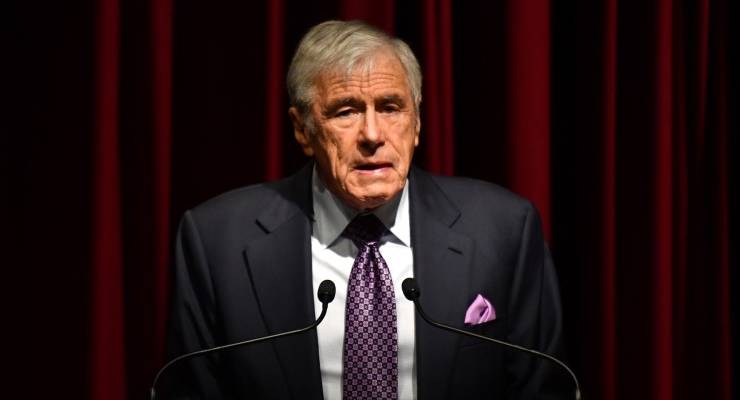
Australia’s struggling legacy broadcast media sector faces a $200 million-plus loss in ad revenues in 2019-20 if first quarter weakness continues. And the loss of revenues is not confined to TV — radio is hit too, raising the question of whether Nine Entertainment stuffed up by buying out Macquarie Media at too high a price.
Annual meetings for Nine and Seven West Media this week — plus the quarterly results from Foxtel last week and the recent trading update from Southern Cross — all revealed that the broadcast ad market has continued its 2018-19 decline.
The updates confirm that commercial TV and radio are being strangled by revenue slide; by falling viewer numbers, rising cost pressures and the growth of streaming.
That’s why the previews for 2020 programming from the three commercial networks and the ABC all highlight shows that saw viewer dips in 2018 and 2019: The Block, My Kitchen Rules, MasterChef Australia, news broadcasts, sports broadcasts (including grand finals), A Current Affair, 7.30, 60 Minutes, Today — the list goes on.
Nine CEO Hugh Marks said on Tuesday that “the market was down by 6.4% on last year … pretty much in line with the overall ad market. Early signs of an improvement in Q2, given a broadly flat September, have unfortunately dissipated in recent weeks. The FTA market in the second quarter looks like being down by at least as much as Q1 — we now expect the market to decline by mid-single digits across the full financial year.”
September quarter commercial radio revenues fell 10.2%, with big falls in all capitals — the largest being more than 15% in Perth and over 11% in Sydney (Nine has two of its AM talk stations in each city). Marks admitted that Nine’s radio business (mainly 2GB in Sydney and 3AW in Melbourne) was feeling the pinch with recent advertiser boycotts of Alan Jones.
It’s a treadmill that none of the networks can break free of — either by takeover or sale — leaving failure or a meandering future the only options. Ten has already collapsed and returned under CBS ownership. Nine has made its big play — the takeover of Fairfax Media and then mopping up of Macquarie Media.
Kerry Stokes has said Seven is not up for sale — but it remains under-pressure from high debt and falling revenues and profits. Seven West Media CEO James Warburton told the company’s annual meeting that “we are now forecasting the metropolitan television market to be down mid-single digits for the financial year”.
And News Corp revealed in its quarterly filing for the three months to September that Foxtel’s ad revenues fell to US$51 million from US$57 million a year ago.
Industry lobby group Think TV said in August that total broadcast revenues including broadcast video on demand (BVOD) saw a 4% fall in 2018-19 to $3.98 billion. Metro revenue was down 5.1% at $2.71 billion. Regional TV revenues fell nearly 5% to $725 million. National revenues fell 4.8% to $416 million, but BVOD revenues jumped 32% to $124 million. With most estimates projecting “mid-single digit” falls for 2019-20, total revenues look like they’ll be down around $240 to $260 million across the sector.
Nine is forecasting a 10% fall in first-half profit, but for that and more to be made up for in the second half (the gains coming from non-broadcast areas) and is forecasting “low single digit growth” in group earnings before interest, tax, depreciation and amortisation (EBITDA) this financial year. Previously in August at its full year results, Nine said it expected to report EBITDA growth of around 10%.
Seven West Media was looking for a fall in earnings before tax and interest of around 5% to 10%, to a range of $190 million to $200 million (down from $212 million in 2018-19). Now it says the fall will be more like 10% to around $190 million. Southern Cross is looking at a lower profit in 2019-20 than in 2018-19.
The future isn’t pretty.








Our reading material has not become free, we have just lost sight of the puppet strings. However we do have the freedom to buy our own choice of journalism. It is a good start to subscribe to Crikey, including its digests of links to other sources. Other perspectives may need to be bought, too. Otherwise we become the goods for sale, hooked by apparently free clickbait.
Wonderful news – the soul-less leeches deserve to fail painfully.
the meejas going broke, best news in decades, now a funeral notice for rupert will be the next good news , but the wailing and crocodile tears from the 2GB shock jocks will be heart rending sob sob , the bolt will be devastated, maybe Pell can say a few words over the coffin before someone drives the stake in to make sure the evil old bastard does`nt come back again, ahh to dream t
o dream.
A quick look at the program guide for the main commercials is grim reading. Wall to wall faux reality in one form or another. Scripted material is now the poor cousin relegated to the secondaries. My take may not be too accurate as I completely gave up on the commercials some decades back – except for the footy and cricket of course.
There’s now no point trying to nobble the ABC and SBS. Dreaded competition is a terrible thing and it’s broken out everywhere. I can watch ad free Netflix for ten bucks a month, online sbs and abc when I want and a whole world of actually interesting and either entertaining or informative (sometimes even both !) stuff on YouTube.
Like the rapacious monopolist recorded music businesses of yore this lazy self satisfied lot saw a train rushing towards them but couldn’t be arsed moving. Good riddance.
Poor old Kerry. He can always go back to selling caterpillar earthmoving equipment and as a sideline offer ignorant, gratuitous, insulting advice to people coping with bushfire emergencies.